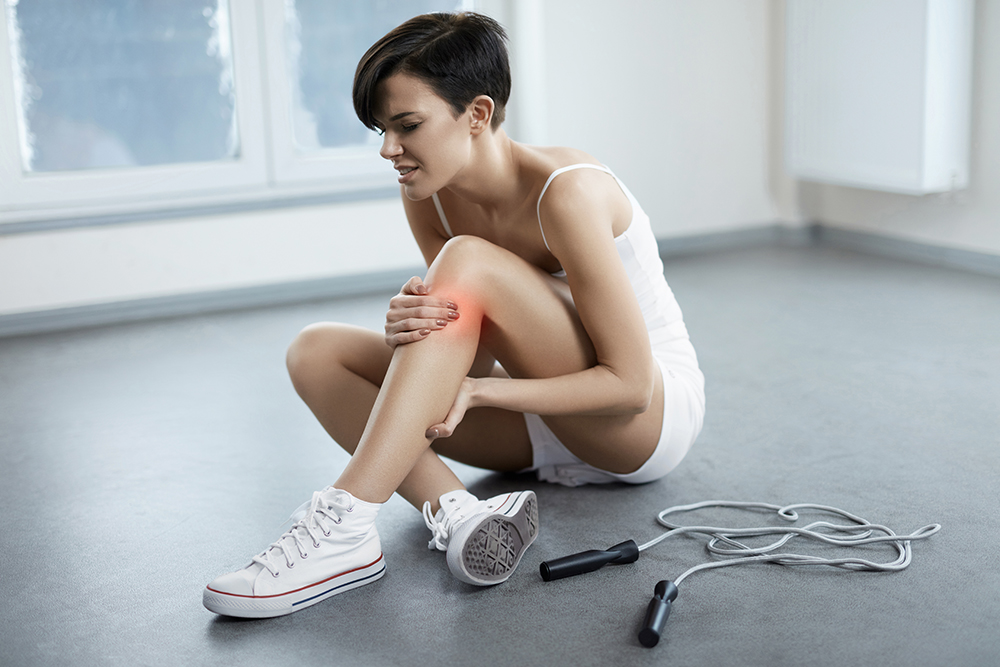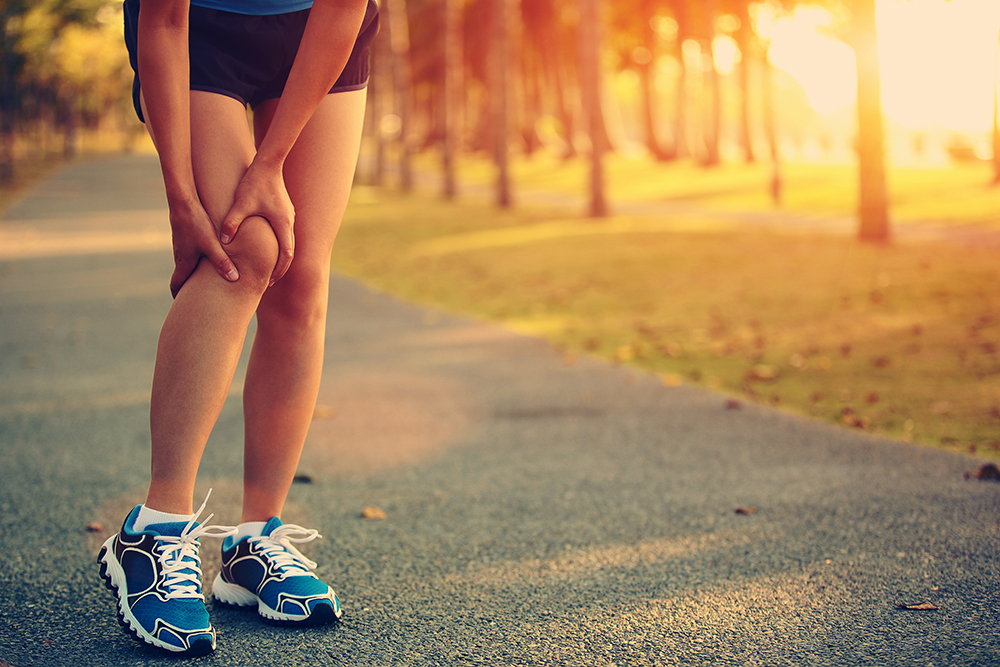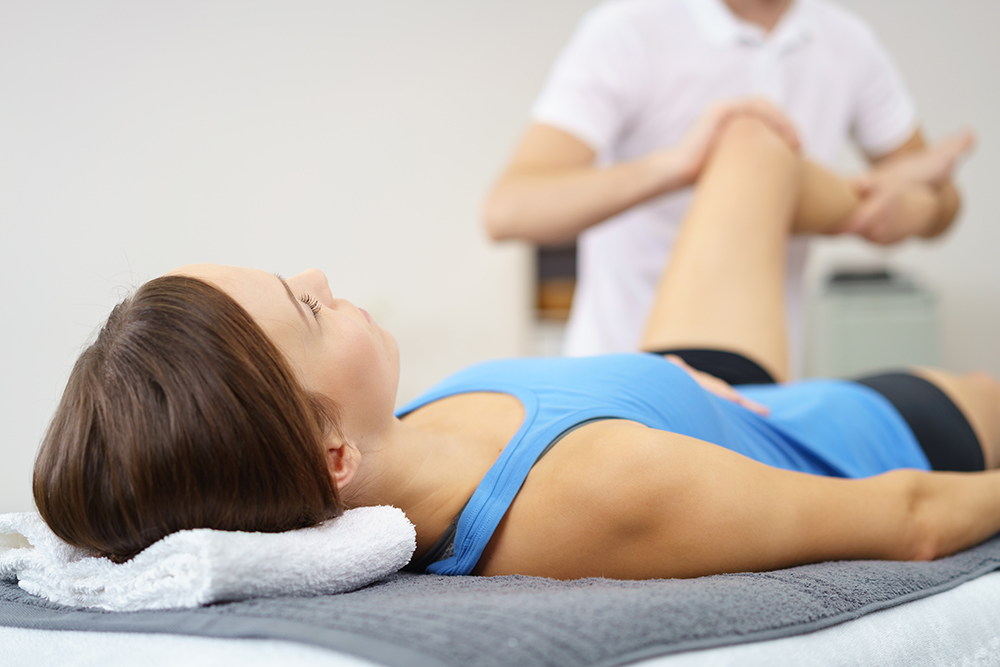Knee Pain
Sudden pain in one of the knees is usually the result of overusing the knee or injuring it. In many cases, you don’t need to see your GP. The knee joint is particularly vulnerable to damage and pain because it takes the full weight of your body and any extra force when you run or jump. You’re more likely to experience knee pain as you get older, and people who are overweight or do lots of sports have a higher risk of damaging their knees. Some sports that involve a lot of turning, such as football, netball and skiing, carry a particularly high risk of knee injuries.
Common causes of knee pain
If you think your pain is the result of having done more activity than you’re used to, you’ve probably just sprained or strained your knee. This means that the knee tissues have stretched, but aren’t permanently damaged. Most sprains and strains can be managed yourself using PRICE therapy (protection, rest, ice, compression and elevation) and painkillers. You can prevent future injuries by:
• always warming up before exercising and
stretching to cool down after exercise
• increasing your activity levels slowly
over time
• replacing your sports shoes when necessary
You can also try low-impact exercises, such as cycling and swimming, to improve your health and fitness without harming your knees.
Knee pain felt at the front of the knee, around the kneecap, is called anterior knee pain or patellofemoral pain syndrome. It’s not always obvious why this pain develops, but it’s been linked to previous injuries, overuse of your knees, muscle weakness and your kneecap being slightly out of place. The pain tends to be dull or aching and often affects both knees at the same time. It’s usually made worse by sitting for prolonged periods, squatting or kneeling, or using stairs. You can normally treat this yourself using ordinary painkillers, an ice pack and rest. Exercises to strengthen the muscles around your kneecap can also help. You may be referred to a physiotherapist, who can advise you about specific exercises to try.
Sitting between the upper and lower leg bones at the knee joint are rubbery pads of tissue called menisci. These cushion the bones, acting as shock absorbers. A meniscus can also be torn after suddenly twisting the knee joint, resulting in pain, swelling and occasionally locking of the knee. Rarely, the torn meniscus can flip into the joint and prevent you from straightening it. A meniscus can also be torn after suddenly twisting the knee joint, resulting in pain, swelling and occasionally locking of the knee. The cartilage covering the bones of the knee joint can also be damaged by injury. These symptoms may settle down with rest, although physiotherapy can sometimes help, and in the case of menisci damage, an operation may be needed to remove or repair the torn pad of tissue.
In older people, recurrent pain and stiffness in both knees is likely to be caused by osteoarthritis, the most common type of arthritis in the UK. Osteoarthritis causes damage to the articular cartilage (protective surface of the knee bone) and mild swelling of the tissues in and around the joints. The pain in your joints may be worse after putting weight on your knees and your knees may become stiff if you don’t move them for a while. They may also occasionally become locked or feel as though they’re going to give way. In some cases, osteoarthritis can also cause a painful fluid-filled swelling to develop at the back of the knee – this is known as a Baker’s cyst, or popliteal cyst. Less commonly, osteoarthritis can affect younger people, especially those who are overweight or have had serious injuries to the knee in the past. You should see your GP if you think your knee pain may be caused by osteoarthritis. They may recommend wearing suitable footwear to reduce the strain on your joints, using assistive devices such as a walking stick, losing weight, taking painkillers, or having physiotherapy.
Overusing or injuring the tendon that connects the kneecap to the shin bone can cause patellar tendonitis (inflammation of the tendon). This condition is sometimes called “jumper’s knee”, as it can be brought on by jumping activities such as basketball or volleyball.
As well as feeling painful and tender, your knee may also be swollen, red and warm. The pain can often be relieved with rest, ice packs and painkillers at home.
Repetitive movement of the knee or kneeling for long periods can cause a build-up of fluid over the knee joint, known as bursitis or “housemaid’s knee”. This particularly affects people with certain jobs that involve kneeling (such as carpet layers), or sports players (such as footballers).
It typically causes pain in the knee that gets worse when you kneel or bend your knee fully. Your knee will also probably be swollen and may be tender, red and warm. Bursitis can often be treated at home. Resting the affected area and using an ice pack helps reduce the swelling and ordinary painkillers can help relieve the pain until your knee heals. Read more about treating bursitis. If you develop redness that spreads, a high temperature (fever), or persistent pain, this may be due to infection of the bursae. You should see your GP urgently, or go to your nearest accident and emergency (A&E) department.
Knee pain may be caused by torn ligaments or tendons. Ligaments are tough bands of tissue that connect the bones at the knee joint; tendons connect the muscles to the bone. You can tear these tissues during running sports such as rugby or football. Injured tendons or knee ligaments at the side of the knee may cause pain even when the knee is at rest, which may get worse when you bend the knee or put weight on it. There may also be warmth and swelling around the knee. If you feel that your knee is also unstable or keeps “giving way”, you may have torn the anterior cruciate ligament (one of the main knee ligaments). This probably resulted from a sudden change in direction or a twisting movement, and you may have heard a pop when it happened. You should see your GP if this happens, and you may be referred to an orthopaedic specialist for advice and treatment. In some cases, surgery may be recommended.
An injury that causes significant damage to the knee joint may cause bleeding into the joint spaces, known as haemarthrosis. This can happen if a cruciate ligament is torn or if there is a fracture to one of the bones of the knee. Signs of haemarthrosis are swelling of the knee, warmth, stiffness and bruising. You should go to hospital immediately to have your knee treated if you have a badly swollen knee. Surgery may be required to repair the damage. If you take anticoagulant medication such as warfarin, bleeding into the joint can happen without any obvious damage. You should see your GP in this case as you may need treatment to reverse the effects on your medication.
In teenagers and young adults, pain, swelling and tenderness in the bony lump just below the kneecap could be a sign of Osgood-Schlatter’s disease. This is a where the bone at the top of the lower leg becomes damaged during a growth spurt. It’s relatively common in active children who participate in sports that involve running, jumping and repetitive bending on the knees. Reducing activity levels, taking painkillers and using ice packs can help relieve the pain in most children. The problem will normally resolve completely once your child stops having growth spurts, although occasionally it can persist into adulthood.
If you experience sudden attacks of severe knee pain and your knee also becomes red and hot, the cause is likely to be gout, which is a type of arthritis. Gout is caused by a build-up of uric acid (a waste product) in the body, which can form crystals in the joints. These crystals cause the joints to become inflamed and painful. Gout will cause severe pain in the knee and limit movement of the joint. You may feel pain even when you’re resting, including at night. Gout can affect any joint in the body and sometimes other joints such as the joint of your big toe may be affected before your knees. You should see your GP if you think the cause of your knee pain is gout. They may recommend using ice packs and taking non-steroidal anti-inflammatory drug (NSAID) painkillers. You may also need to change your diet or receive additional treatment to prevent attacks if you experience them frequently.
Septic arthritis is a serious condition that causes a very painful, hot, swollen knee. You may also feel generally unwell and have a fever.
It can be mistaken for gout (see above). You should see your GP urgently, or go to your nearest accident and emergency (A&E) department if you suspect you have septic arthritis. Septic arthritis is treated by draining fluid from the knee before antibiotics are given. Occasionally arthroscopic surgery is needed to clear out the infection.
When to see your GP or an Orthopaedic Surgeon
You should see your GP if:
• you cannot put weight on your knee at all
• you have severe pain even when you’re not putting weight on
it, such as at night
• your knee locks or painfully clicks (painless clicking is
OK)
• your knee keeps giving way
• you’re unable to fully bend or straighten your knee
• your knee looks deformed
• you have fever, redness or heat around the knee, or it’s
very swollen
• you have pain, swelling, numbness or tingling of the calf beneath
your affected knee
• the pain doesn’t start to improve within a few weeks or you
have pain that’s still severe after a few days of caring for
your knee at home
Your GP will do a careful examination of the knee and take your medical history. They may also arrange further tests such as blood tests, an X-ray or a magnetic resonance imaging (MRI) scan to help identify the problem. In some cases, you may need to be referred to an orthopaedic specialist.
For more information on knee pain and the various treatment options please do not hesitate to get in touch with Mr Atwal through our appointments page.



QUICK ENQUIRY


